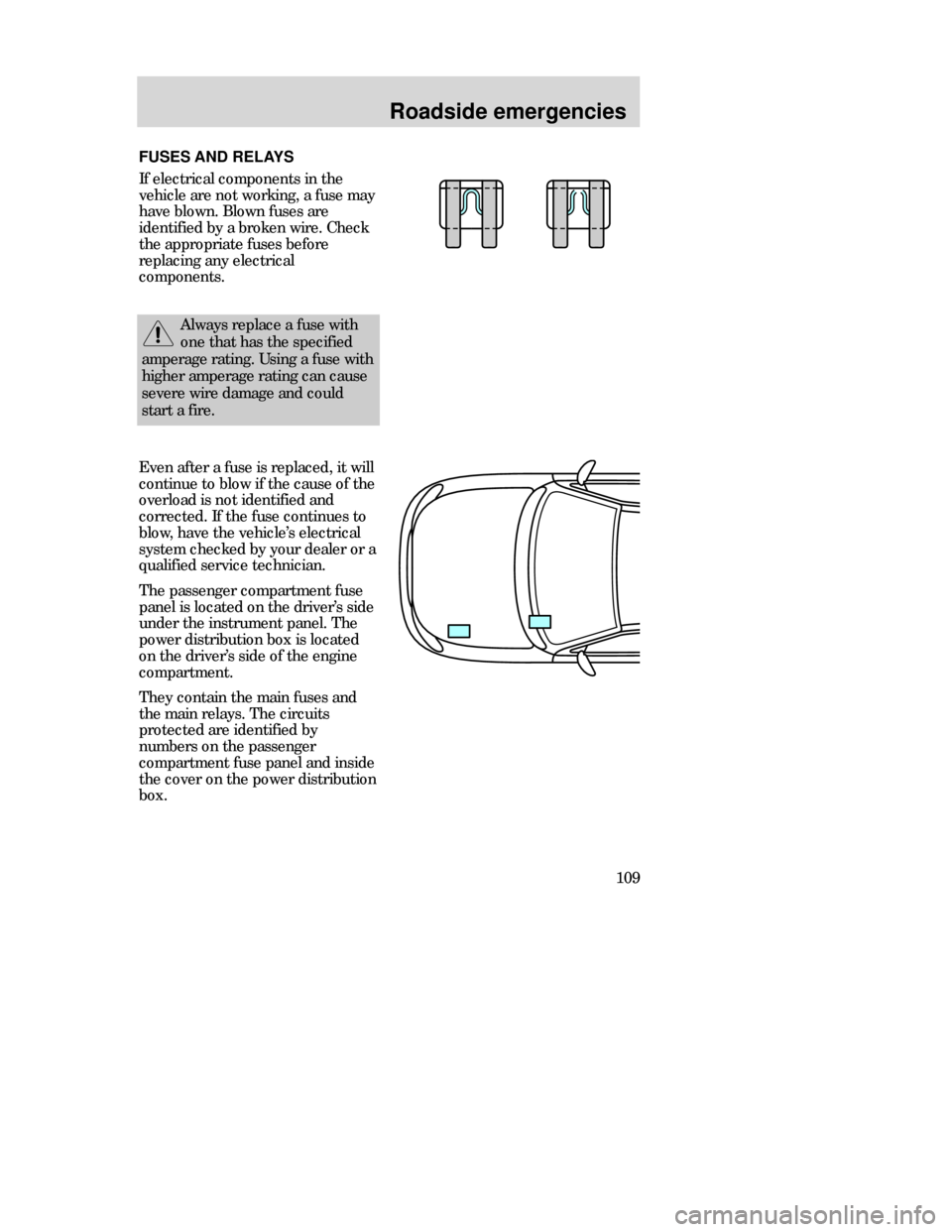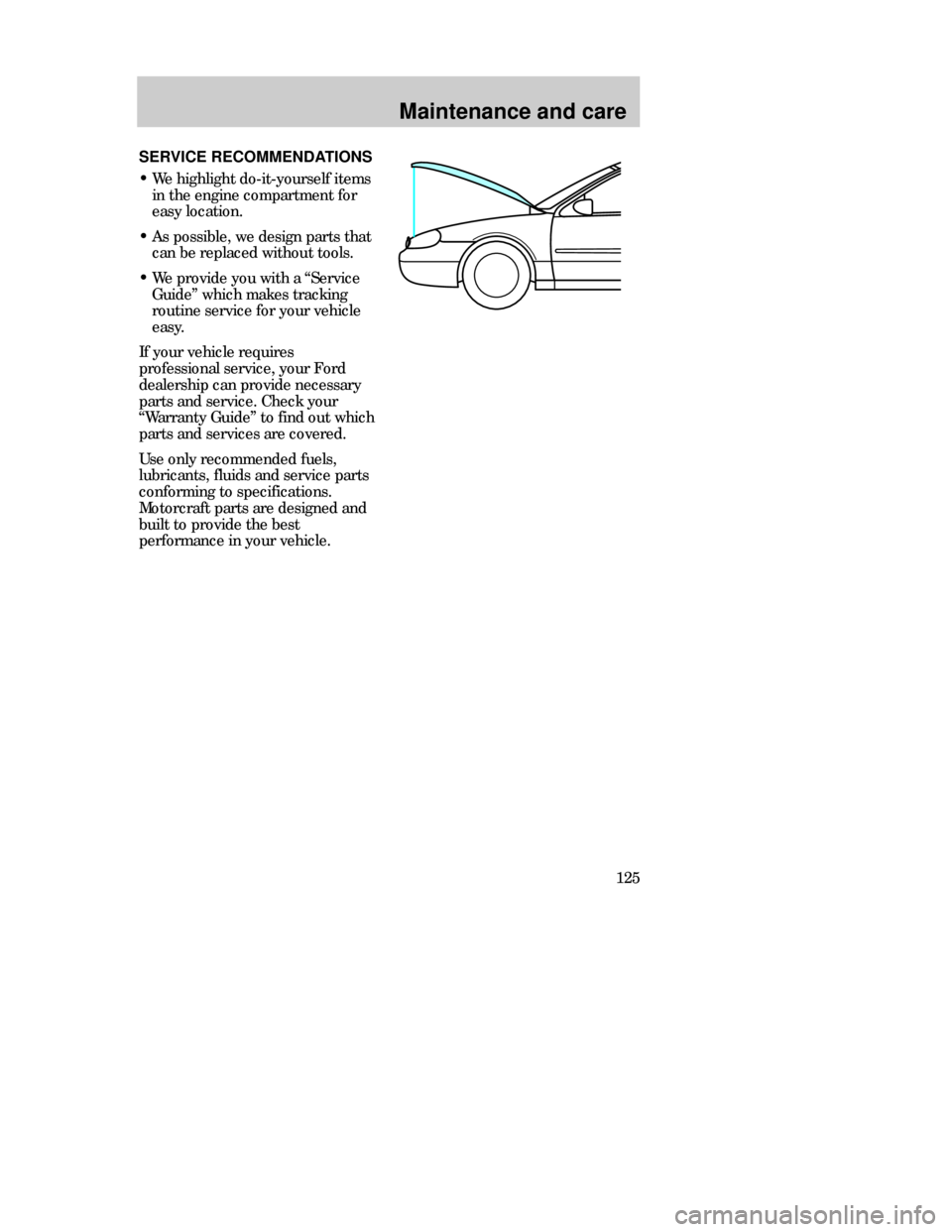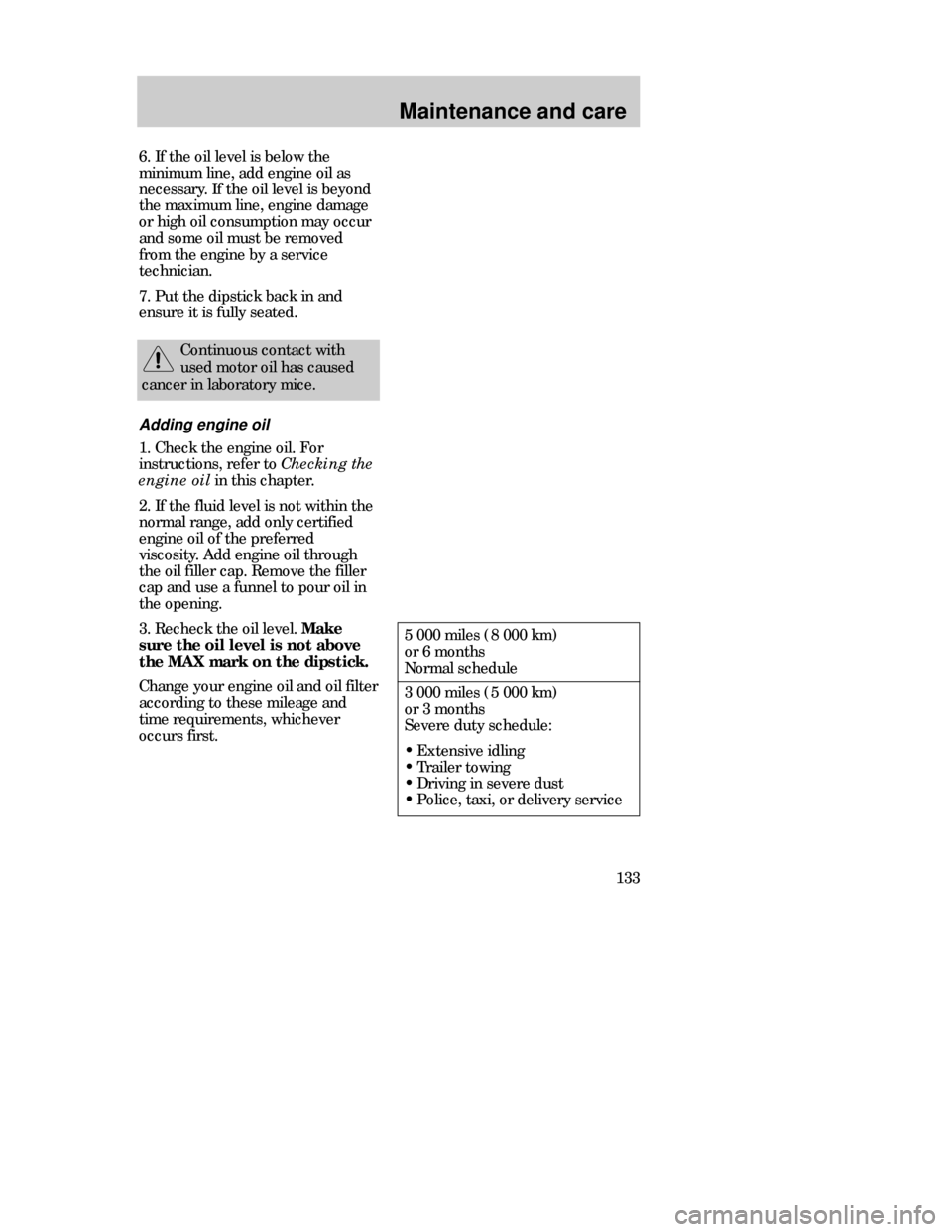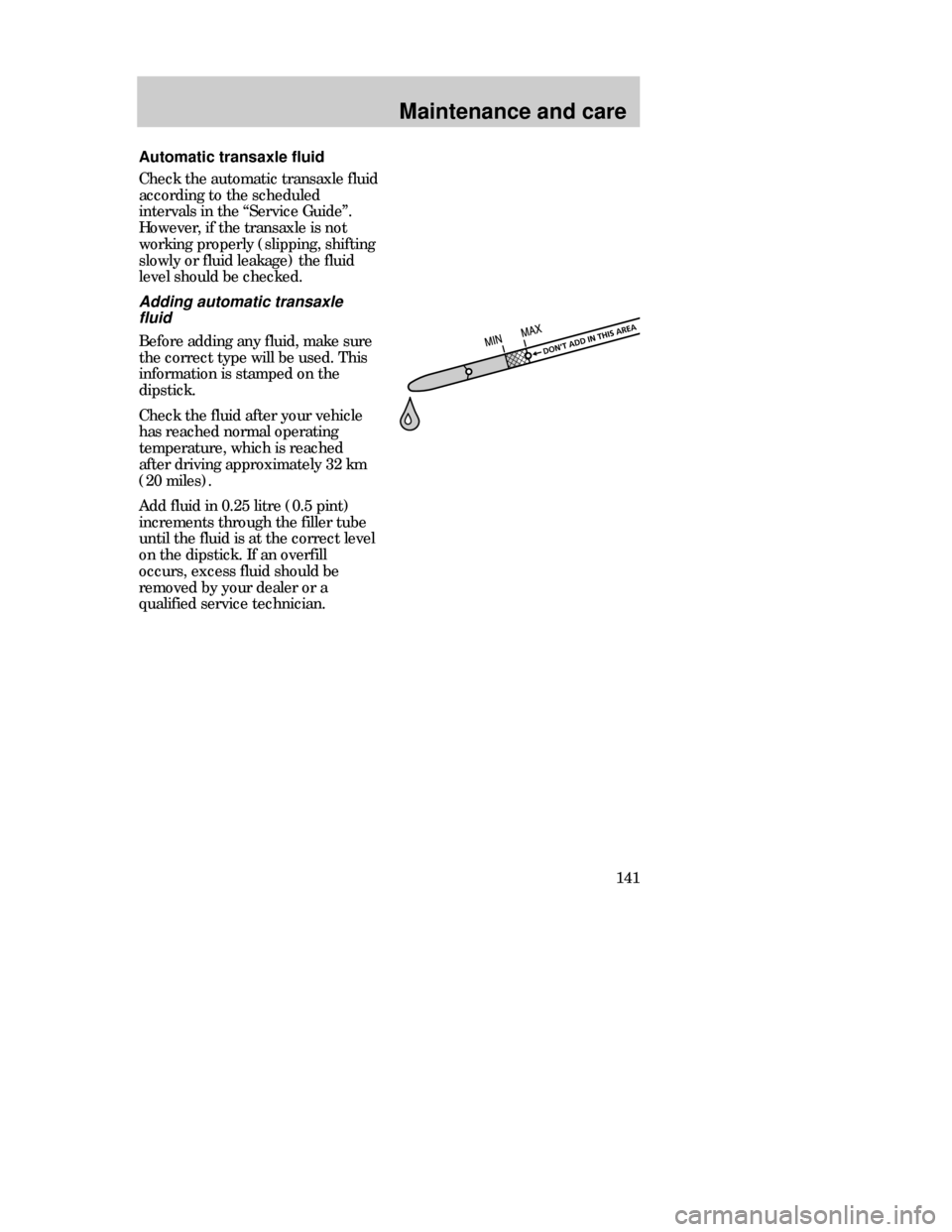service Mercury Mystique 1998 s User Guide
[x] Cancel search | Manufacturer: MERCURY, Model Year: 1998, Model line: Mystique, Model: Mercury Mystique 1998Pages: 196, PDF Size: 1.65 MB
Page 101 of 196

Driving
101 Follow these guidelines to ensure
safe towing procedure:
•Stay within your vehicle’s load
limits.
•Thoroughly prepare your vehicle
for towing. Refer to Preparing to
towin this chapter.
•Use extra caution when driving
while trailer towing. Refer to
Driving while towing a trailer
in this chapter.
•Service your vehicle more
frequently if you tow a trailer.
Refer to the severe duty schedule
in the ”Service Guide”.
•Do not tow a trailer until your
vehicle has been driven at least
800km (500miles).
•Refer to the instructions included
with towing accessories for the
proper installation and
adjustment specifications.
CDW IVB1-10Driving en MM 5/15/97 7:51 PM Page 101
Page 108 of 196

Roadside emergencies
108
If your engine cranks but does not
start after a collision or substantial
jolt:
1. Turn the ignition key to the off
position.
2. Check under the vehicle for
leaking fuel.
3. If you do not see or smell fuel,
push the red reset button down. If
the button is already set, you may
have a different mechanical
problem.
4. Turn the ignition key to the on
position for a few seconds, then
turn it to the off position.
5. Check under the vehicle again
for leaking fuel. If you see or smell
fuel, do not start your vehicle
again. If you do not see or smell
fuel, you can try to start your
vehicle again.
If you see or smell fuel, do
not reset the switch or try to
start your vehicle. Have all the
passengers get out of the vehicle
and call the local fire department
or a towing service.
CDW IVC1-6Roads en MM 5/15/97 7:53 PM Page 108
Page 109 of 196

Roadside emergencies
109 Even after a fuse is replaced, it will
continue to blow if the cause of the
overload is not identified and
corrected. If the fuse continues to
blow, have the vehicle’s electrical
system checked by your dealer or a
qualified service technician.
The passenger compartment fuse
panel is located on the driver’s side
under the instrument panel. The
power distribution box is located
on the driver’s side of the engine
compartment.
They contain the main fuses and
the main relays. The circuits
protected are identified by
numbers on the passenger
compartment fuse panel and inside
the cover on the power distribution
box.
FUSES AND RELAYS
If electrical components in the
vehicle are not working, a fuse may
have blown. Blown fuses are
identified by a broken wire. Check
the appropriate fuses before
replacing any electrical
components.
Always replace a fuse with
one that has the specified
amperage rating. Using a fuse with
higher amperage rating can cause
severe wire damage and could
start a fire.
CDW IVC1-6Roads en MM 5/15/97 7:53 PM Page 109
Page 125 of 196

Maintenance and care
125 SERVICE RECOMMENDATIONS
•We highlight do-it-yourself items
in the engine compartment for
easy location.
•As possible, we design parts that
can be replaced without tools.
•We provide you with a “Service
Guide” which makes tracking
routine service for your vehicle
easy.
If your vehicle requires
professional service, your Ford
dealership can provide necessary
parts and service. Check your
“Warranty Guide” to find out which
parts and services are covered.
Use only recommended fuels,
lubricants, fluids and service parts
conforming to specifications.
Motorcraft parts are designed and
built to provide the best
performance in your vehicle.
CDW VA1-19Maint en MM 5/15/97 7:55 PM Page 125
Page 133 of 196

Maintenance and care
133 6. If the oil level is below the
minimum line, add engine oil as
necessary. If the oil level is beyond
the maximum line, engine damage
or high oil consumption may occur
and some oil must be removed
from the engine by a service
technician.
7. Put the dipstick back in and
ensure it is fully seated.
Continuous contact with
used motor oil has caused
cancer in laboratory mice.
Adding engine oil
1. Check the engine oil. For
instructions, refer to Checking the
engine oilin this chapter.
2. If the fluid level is not within the
normal range, add only certified
engine oil of the preferred
viscosity. Add engine oil through
the oil filler cap. Remove the filler
cap and use a funnel to pour oil in
the opening.
3. Recheck the oil level.
Make
sure the oil level is not above
the MAX mark on the dipstick.
Change your engine oil and oil filter
according to these mileage and
time requirements, whichever
occurs first.5 000 miles (8 000 km)
or 6 months
Normal schedule
3 000 miles (5 000 km)
or 3 months
Severe duty schedule:
•Extensive idling
•Trailer towing
•Driving in severe dust
•Police, taxi, or delivery service
CDW VA1-19Maint en MM 5/15/97 7:55 PM Page 133
Page 139 of 196

Maintenance and care
139
MAX
MIN
Adding engine coolant
1. Before removing the engine
coolant recovery cap, turn the
engine off and allow it to cool.
2. When the engine is cool, turn
and remove the cap.
•Step back for a moment while the
pressure in the reservoir is
released.
•Stand away from the reservoir
opening. Hot steam or coolant
spray may be released.
3. Add engine coolant until the
fluid level in the reservoir is
between the MAX and MIN lines on
the reservoir.
Follow the recommended service
interval for changing engine
coolant as outlined in the “Service
Guide”. Refer to Capacities and
specifications for more
information on engine coolant
specifications.
Have your dealer or a qualified
service technician check the engine
coolant system for leaks if you have
to add more than a litre (quart) of
engine coolant per month.
Never remove the coolant
recovery cap while the
engine is running or hot.
CDW VA1-19Maint en MM 5/15/97 7:55 PM Page 139
Page 141 of 196

Maintenance and care
141 Automatic transaxle fluid
Check the automatic transaxle fluid
according to the scheduled
intervals in the “Service Guide”.
However, if the transaxle is not
working properly (slipping, shifting
slowly or fluid leakage) the fluid
level should be checked.
Adding automatic transaxle
fluid
Before adding any fluid, make sure
the correct type will be used. This
information is stamped on the
dipstick.
Check the fluid after your vehicle
has reached normal operating
temperature, which is reached
after driving approximately 32 km
(20 miles).
Add fluid in 0.25 litre (0.5 pint)
increments through the filler tube
until the fluid is at the correct level
on the dipstick. If an overfill
occurs, excess fluid should be
removed by your dealer or a
qualified service technician.
CDW VA1-19Maint en MM 5/15/97 7:56 PM Page 141
Page 143 of 196

Maintenance and care
143
MotorcraftSUPERSTART
Pb
Battery
Your vehicle may be equipped with
a Motorcraft maintenance-free
battery. The Motorcraft
maintenance-free battery normally
does not require additional water
during its life of service. However,
for severe service usage or in high
temperature climates, check your
battery electrolyte level, at least
every 24 months or 40 000 km
(24 000 miles). Keep the
electrolyte in each cell up to the
“level” indicator. Do not overfill the
battery cell.
For longer, trouble-free operation,
keep the top of the battery clean
and dry. Also, make certain the
battery cables are always tightly
fastened to the battery terminals.
If you see any corrosion on the
battery cables or terminals, remove
the cables from the terminal(s) and
clean with a wire brush. You can
neutralize the acid with a solution
of baking soda and water. Reinstall
the cables when you are done
cleaning them, and apply a small
quantity of grease to the top of
each battery terminal to help
prevent corrosion.
CDW VA1-19Maint en MM 5/15/97 7:56 PM Page 143
Page 144 of 196

Maintenance and care
144Battery replacement
If your original equipment battery
requires replacement while under
warranty, it will be replaced with a
Motorcraft service battery,
identical in design technology. Like
the original equipment battery, it
should not require water addition
during its normal life of service;
however, for severe service usage
or in high temperature climates,
check your battery electrolyte
level, at least every 24 months or
40 000 km (24 000 miles). Do not
overfill the battery cell.
If the electrolyte level in your
battery gets low, you can add plain
tap water to the battery, as long as
you do not use hard water (water
with a high mineral or alkali
content). If possible, however, try
to only fill the battery cell with
distilled water. If the battery needs
water often, have the charging
system checked.
CDW VA1-19Maint en MM 5/15/97 7:56 PM Page 144
Page 150 of 196

Maintenance and care
150Treadwear
The treadwear grade is a
comparative rating based on the
wear rate of the tire when tested
under controlled conditions on a
specified government test course.
For example, a tire grade of 150
would wear one and one-half
(11/2) times as well on the
government course as a tire grade
100. The relative performance of
tires depends upon the actual
conditions of their use, however,
and may depart significantly from
the norm due to variations in
driving habits, service practices,
and differences in road
characteristics and climate.
Traction ABC
The traction grades, from highest
to lowest are A, B, and C, and they
represent the tire’s ability to stop
on wet pavement as measured
under test surfaces of asphalt and
concrete. A tire marked C may
have poor traction performance.
Warning: The traction grade
assigned to this tire is based on
braking (straightahead) traction
tests and does not include
cornering (turning) traction.
CDW VA1-19Maint en MM 5/15/97 7:56 PM Page 150